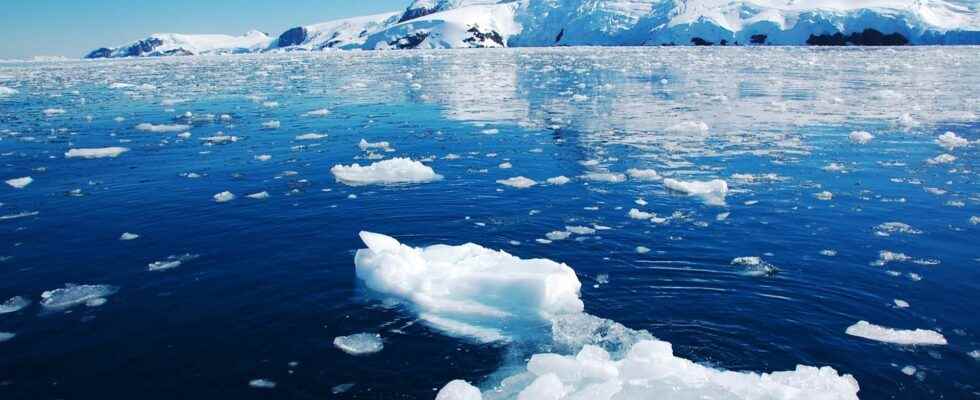You will also be interested
[EN VIDÉO] Antarctica: a gigantic sheet of ice breaks off This video, made from radar images acquired by the TerraSAR-X satellite, shows the evolution of the formation of one of the largest known icebergs. Over the weeks and months, the satellite follows its evolution, from the appearance of the fault in the Larsen C ice shelf until its fragmentation.
Both poles of the Earth are currently experiencing extremely high temperatures for the past few days. In Antarctic and in Arcticthe temperatures were above seasonal averages over 30°C last week.
Absolute heat record in Antarctica
As Antarctica prepared to enter fall (the seasons being reversed in the southern hemisphere compared to thenorthern hemisphere), a record of heat was beaten on Friday March 18: the Concordia station, located at 3,234 meters above sea level, recorded -12.2 ° C, nearly 40 ° C above seasonal averages. This is the highest temperature recorded there in any month.
For its part, the station Vostok, located even higher (3,489 meters), recorded -17.7 ° C, breaking an absolute record. The Dome C-II base, located east of Antarctica at 3,250 meters, recorded a temperature of -10.1 ° C on Friday, while the average is -43 ° C at this time, or 33 ° C of difference. -10°C is the average temperature that the area generally experiences in January, in the middle of summer. The base, near the coast, showed a positive temperature of 7°C on the same day.
In Terre Adélie, the Dumont d’Urville base recorded a mild March record, with 4.9°C, and a record morning temperature of 0.2°C. In some areas of the same continent that lack data weather report precise, it is even possible that the temperatures have reached values located 50 ° C above normal!
These temperatures are exceptional because, at this time of the year, the temperature is supposed to drop rapidly day by day after the summer solstice of December. More generally, the average temperature recorded over the entire Antarctic continent on Friday March 18 was 4.8°C above the 1979-2000 average according to Climate Reanalyzer.
The temperature anomaly reaches +30 to +35°C currently on the East Antarctic plateau. Concordia at Dome C set a new absolute high temperature record, all months combined: -12.2°C, compared to -13.7°C on December 17, 2016. Data since 2005. pic.twitter.com/wq97TE1s4n
— Gaetan Heymes (@GaetanHeymes) March 18, 2022
Why such an increase in temperatures last Friday? The fault of one atmospheric river, a band of moisture that circulates in the atmosphere and sometimes reaches certain lands. If this phenomenon is not rare, it is on the other hand exceptional that it concerns Antarctica, as explained Gaetan Heymes, meteorologist from Météo France, specialist in Antarctica:
” Ihe atmospheric river carries large amounts of water vapor from the Southern Ocean to Antarctica. This region is a desert ice with little water vapor and this water vapor increases humidity, hence snow and cloudiness, which raises temperatures. Water vapor is also one of the greenhouse gases that contribute to global warming. »
According to National Snow and Ice Data Center, it is difficult to link this isolated event with certainty to global warming. However, with climate change, it is quite possible that such extremes will repeat themselves regularly over the next few years.
The Arctic also affected by temperatures 30 ° C above average
At the other end of the planet, the Arctic also shows abnormally high temperatures, with near positive temperatures at the North Pole. An exceptional event for this time of year. Remember that these two areas, Antarctica and the Arctic, are located at the two poles of the planet and therefore experience different seasons: autumn at the South Pole, and spring at the North Pole.
It is therefore particularly surprising to have such high temperatures, 30°C above average in certain areas of the two poles, with already a melting ice locally, at the same time on both sides. On the day when the Antarctic showed a deviation of 4.8°C from its average, the Arctic showed a global deviation of 3.3°C compared to the same period (1979-2000). At the global level, the planet showed last Friday a difference of 0.6 ° C compared to the average.
Both ends of the globe heat up faster than the rest of the world, in particular the Arctic for which this warming is 2 to 3 times faster than elsewhere on the globe according to NOAA.
Support your independent scientific media: discover our subscription formulas!
4 good reasons to subscribe to Futura on Patreon:
- A site without any advertising from 3.29 euros per month.
- It is without commitment.
- Access to priority content, in preview, just for you.
- You support our business in the best possible way. A real motivation for us!
Interested in what you just read?
